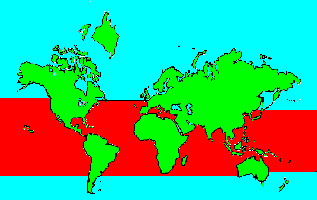SPECIES INFO
Short fin mako shark (Isurus oxyrinchus) is found in temperate and tropical oceans around the world. In North America it is found as far north as British Columbia and New York, and in Europe as far north as Scandanavia. It is found as far south as Australia and as far north as Japan. It is found as far south as South Africa.
This shark can grow to about 400 cm (About 12 feet) long. However, questionable records exist to about 20 feet in length. The dorsal side is bright blue or purple. The underside is white. This is a fast swimming shark, perhaps the fastest known. This is a popular big game fish.
There is an image on page 16 of the Diamond Handbook by Nichols and Miller on the fishes of Britain and Europe. The Lythgoes note this is a solitary shark found in open shallow water. This shark can be easily confused with the Porbeagle(Lamna nasus). Schwartz noted in 2003 that this species is common in the western Atlantic Gulf Stream near the Carolinas.The mako shark genus (Isurus) is found worldwide. There are only two species. Both are considered sporting game fish. Both species can grow to over 12 feet in length. These are aggressive sharks, and they are known to attack boats. They will also attack humans. When hooked they will jump up to 30 feet in the air, and can come crashing down anywhere!
Mackeral Sharks (Lamnidae) contain the most dangerous of all sharks. Included in this family is the Great White Shark, probably the most dangerous shark known. The Shortfin Mako (Isurus oxyrhinchus) also belongs in this family. Several species of this family can swim very quickly, and easily feed on various fast swimming fish.
True Shark group (Order Lamniformes) used to contain the majority of the world's species of living sharks. They were characterized by having five gill slits. Some taxonomists recognized over fifteen families in this order. However, this order has been recently divided and several families that were previously here have been moved to the ground shark order (Carchariniformes). Other families have been moved to other orders.
The Reader's Digest book on sharks has several maps showing the relative frequency of shark attacks. Naturally, in areas where there is a lot of swimming and diving you would expect a greater number of attacks. In Australia the area near Sidney and Newcastle are subject to numerous attacks. The southern coast of Papua New Guinea is also dangerous. The area near Durban, South Africa is also dangerous. In North America areas near Savanah, Georgia and Miami are also risky. Cuba is also dangerous.
Sharks and rays (Elasmobranchi), cartilaginous fishes, deserve to be a class separate from the normal fish, in that they do not have a bone skeleton but rather a cartilage skeleton.
Fertilization is internal in this class which also separates them from the bony fish class. Although there are a few fresh water species, the majority of the species in this class are found in salt water. As of 2005, there were about 500 known species of sharks and about 600 known species of rays.
David Ebert, author of a recent book on sharks, rays, and chimaeras of California, counts a total of 988 described species in the class with about 150 additional species awaiting scientific description. He breaks down the described species to 410 species of sharks, 543 species of rays, and 35 species of chimaeras.
Many species of sharks face an uncertain future, as the Chinese purchase shark fins to make shark fin soup. It was estimated that 100 milllion sharks are killed each year for this purpose. However, recent estimates indicate the Chinese are reducing their consumption of this exotic soup.
Backboned Animals (Phylum Chordata) are the most advanced group of animals on earth. These animals are characterized by having a spinal cord or backbone. Most members have a clearly defined brain that controls the organism through a spinal cord. Fish, amphibians, reptiles, birds, and mammals are in this phylum.
Currently, some taxonomists believe that the fish should be divided into two groups (sharks and regular fishes) and that there are some other primitive groups in the phylum such as hagfish or lampreys.
Animal Kingdom contains numerous organisms that feed on other animals or plants. Included in the animal kingdom are the lower marine invertebrates such as sponges and corals, the jointed legged animals such as insects and spiders, and the backboned animals such as fish, amphibians, reptiles, birds, and mammals.

